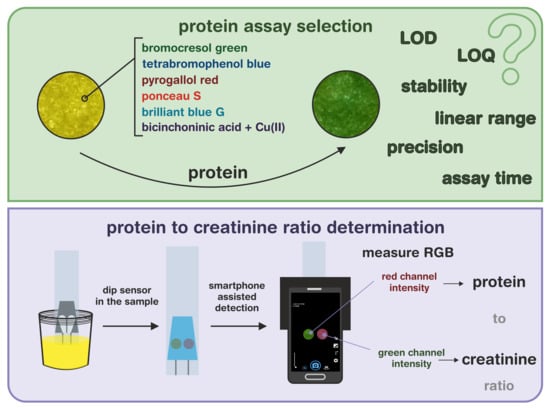Smartphone-Assisted Protein to Creatinine Ratio Determination on a Single Paper-Based Analytical Device
Abstract
:1. Introduction
2. Materials and Methods
2.1. Materials and Instruments
2.2. Sensor Preparation
2.3. Sensing Procedure
2.4. Smartphone Modification and Signal Processing
2.5. Artificial Urine Preparation
3. Results and Discussion
3.1. Dye-Binding Assay Optimization
3.2. Assay Comparison
3.3. Protein to Creatinine Ratio Determination
3.4. Real Sensing Scenario
3.5. Towards Calibration-Free Sensors
4. Conclusions
Supplementary Materials
Author Contributions
Funding
Institutional Review Board Statement
Informed Consent Statement
Acknowledgments
Conflicts of Interest
Sample Availability
References
- Keane, W.F.; Eknoyan, G. Proteinuria, albuminuria, risk, assessment, detection, elimination (PARADE): A position paper of the National Kidney Foundation. Am. J. Kidney Dis. 1999, 33, 1004–1010. [Google Scholar] [CrossRef]
- Lamb, E.J.; MacKenzie, F.; Stevens, P.E. How should proteinuria be detected and measured? Ann. Clin. Biochem. 2009, 46, 205–217. [Google Scholar] [CrossRef] [PubMed] [Green Version]
- Côté, A.M.; Firoz, T.; Mattman, A.; Lam, E.M.; von Dadelszen, P.; Magee, L.A. The 24 h urine collection: Gold standard or historical practice? Am. J. Obstet. Gynecol. 2008, 199, 625.e1–625.e6. [Google Scholar] [CrossRef]
- Rodby, R.A.; Rohde, R.D.; Sharon, Z.; Pohl, M.A.; Bain, R.P.; Lewis, E.J. The urine protein to creatinine ratio as a predictor of 24-h urine protein excretion in type 1 diabetic patients with nephropathy. Am. J. Kidney Dis. 1995, 26, 904–909. [Google Scholar] [CrossRef]
- Kumar, A.; Kapoor, S.; Gupta, R.C. Comparison of urinary protein: Creatinine index and dipsticks for detection of microproteinuria in diabetes mellitus patients. J. Clin. Diagn. Res. 2013, 7, 622–626. [Google Scholar] [CrossRef] [PubMed]
- Martinez, A.W.; Phillips, S.T.; Butte, M.J.; Whitesides, G.M. Patterned paper as a platform for inexpensive, low-volume, portable bioassays. Angew. Chem.-Int. Ed. 2007, 46, 1318–1320. [Google Scholar] [CrossRef] [PubMed] [Green Version]
- Gong, M.M.; Sinton, D. Turning the Page: Advancing Paper-Based Microfluidics for Broad Diagnostic Application. Chem. Rev. 2017, 117, 8447–8480. [Google Scholar] [CrossRef] [PubMed]
- Cai, Y.; Niu, J.C.; Du, X.L.; Fang, F.; Wu, Z.Y. Novel field amplification for sensitive colorimetric detection of microalbuminuria on a paper-based analytical device. Anal. Chim. Acta. 2019, 1080, 146–152. [Google Scholar] [CrossRef] [PubMed]
- Niu, J.C.; Zhou, T.; Niu, L.L.; Xie, Z.S.; Fang, F.; Yang, F.Q.; Wu, Z.Y. Simultaneous pre-concentration and separation on simple paper-based analytical device for protein analysis. Anal. Bioanal. Chem. 2018, 410, 1689–1695. [Google Scholar] [CrossRef]
- Jiang, X.; Li, F.; Niu, J.; Bao, Z.; Wei, Z.; Li, J.X.; Gao, B. A three-dimensional paper-based isoelectric focusing device for direct analysis of proteins in physiological samples. Anal. Chem. 2021, 93, 3959–3967. [Google Scholar] [CrossRef]
- Gao, H.; Liu, J.J.; Liu, Y.Q.; Wu, Z.Y. Detection of urine protein by a paper-based analytical device enhanced with ion concentration polarization effect. Microfluid. Nanofluidics 2019, 23, 1–7. [Google Scholar] [CrossRef]
- Sechi, D.; Greer, B.; Johnson, J.; Hashemi, N. Three-dimensional paper-based microfluidic device for assays of protein and glucose in urine. Anal. Chem. 2013, 85, 10733–10737. [Google Scholar] [CrossRef] [PubMed] [Green Version]
- Yamada, K.; Suzuki, K.; Citterio, D. Text-Displaying Colorimetric Paper-Based Analytical Device. ACS Sens. 2017, 2, 1247–1254. [Google Scholar] [CrossRef]
- Pokhrel, P.; Jha, S.; Giri, B. Selection of appropriate protein assay method for a paper microfluidics platform. Pract. Lab. Med. 2020, 21, e00166. [Google Scholar] [CrossRef] [PubMed]
- Chaiyo, S.; Kalcher, K.; Apilux, A.; Chailapakul, O.; Siangproh, W. A novel paper-based colorimetry device for the determination of the albumin to creatinine ratio. Analyst 2018, 143, 5453–5460. [Google Scholar] [CrossRef]
- Hiraoka, R.; Kuwahara, K.; Wen, Y.-C.; Yen, T.-H.; Hiruta, Y.; Cheng, C.-M.; Citterio, D. Paper-Based Device for Naked Eye Urinary Albumin/Creatinine Ratio Evaluation. ACS Sens. 2020, 5, 1110–1118. [Google Scholar] [CrossRef] [PubMed]
- Lewińska, I.; Speichert, M.; Granica, M.; Tymecki, Ł. Colorimetric point-of-care paper-based sensors for urinary creatinine with smartphone readout. Sens. Actuators B Chem. 2021, 340, 129915. [Google Scholar] [CrossRef]
- Carrilho, E.; Martinez, A.W.; Whitesides, G.M. Understanding Wax Printing: A Simple Micropatterning Process for Paper-based Microfluidics. Anal. Chem. 2009, 81, 7091–7095. [Google Scholar] [CrossRef] [PubMed]
- Ellerbee, A.K.; Phillips, S.T.; Siegel, A.C.; Mirica, K.A.; Martinez, A.W.; Striehl, P.; Jain, N.; Prentiss, M.; Whitesides, G.M. Quantifying colorimetric assays in paper-based microfluidic devices by measuring the transmission of light through paper. Anal. Chem. 2009, 81, 8447–8452. [Google Scholar] [CrossRef]
- Doumas, B.T.; Watson, W.A.; Biggs, H.G. Albumin standards and the measurement of serum albumin with bromcresol green. Clin. Chim. Acta. 1997, 258, 21–30. [Google Scholar] [CrossRef]
- Watanabe, N.; KameI, S.; Ohkubo, A.; Tokuda, K. Urinary Protein as Measured with a Pyrogallol Red-Molybdate Complex, Manually and in a Hitachi 726 Automated Analyzer. Clin. Chem. 1986, 32, 1551–1554. [Google Scholar] [CrossRef] [PubMed]
- Thompson Hayner, N.; Driscoll, J.; Ferayorni, L.; Spies-Karotkin, G.; Jauregui, H.O. Ponceau S: A Sensitive Method for Protein Determination. J. Tissue Cult. Methods. 1982, 7, 78–80. [Google Scholar]
- Kruger, N.J. The Bradford Method for Protein Quantitation. In Basic Protein and Peptide Protocos; Methods in Molecular Biology™; Walker, J.M., Ed.; Humana Press: Totowa, NJ, USA, 1994. [Google Scholar] [CrossRef]
- Walker, J.M. The Bicinchoninic Acid (BCA) Assay for Protein Quantitation. In Basic Protein and Peptide Protocols; Methods in Molecular Biology™; Walker, J.M., Ed.; Humana Press: Totowa, NJ, USA, 1994; Volume 32. [Google Scholar] [CrossRef]
- Dube, J.; Girouard, J.; Leclerc, P.; Douville, P. Problems with the estimation of urine protein by automated assays. Clin. Biochem. 2005, 38, 479–485. [Google Scholar] [CrossRef]
- Bannur, S.V.; Kulgod, S.V.; Metkar, S.S.; Mahajan, S.K.; Sainis, J.K. Protein determination by ponceau S using digital color image analysis of protein spots on nitrocellulose membranes. Anal. Biochem. 1999, 267, 382–389. [Google Scholar] [CrossRef] [PubMed]
- Land, K.J.; Boeras, D.I.; Chen, X.S.; Ramsay, A.R.; Peeling, R.W. REASSURED diagnostics to inform disease control strategies, strengthen health systems and improve patient outcomes. Nat. Microbiol. 2019, 4, 46–54. [Google Scholar] [CrossRef]
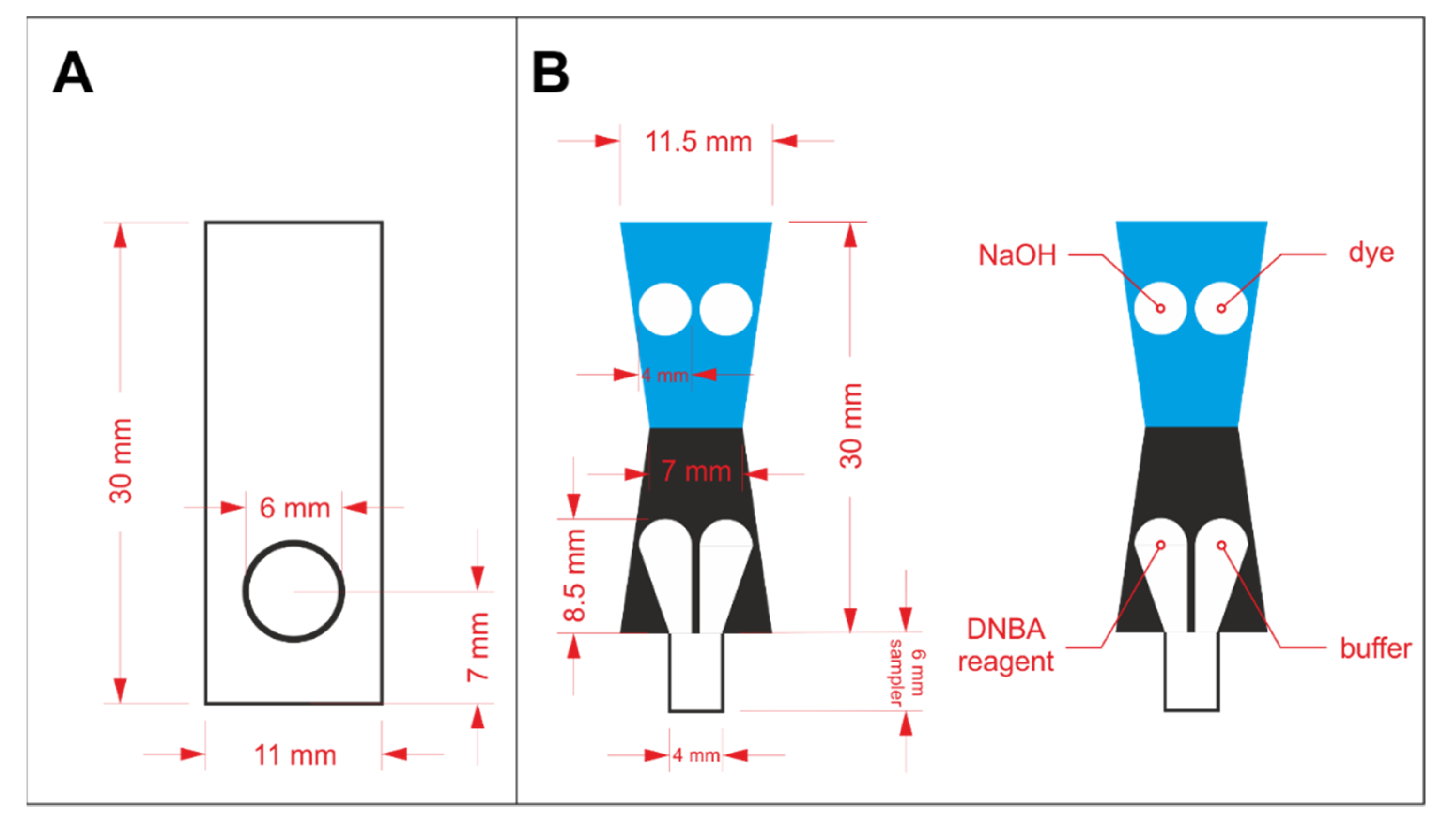

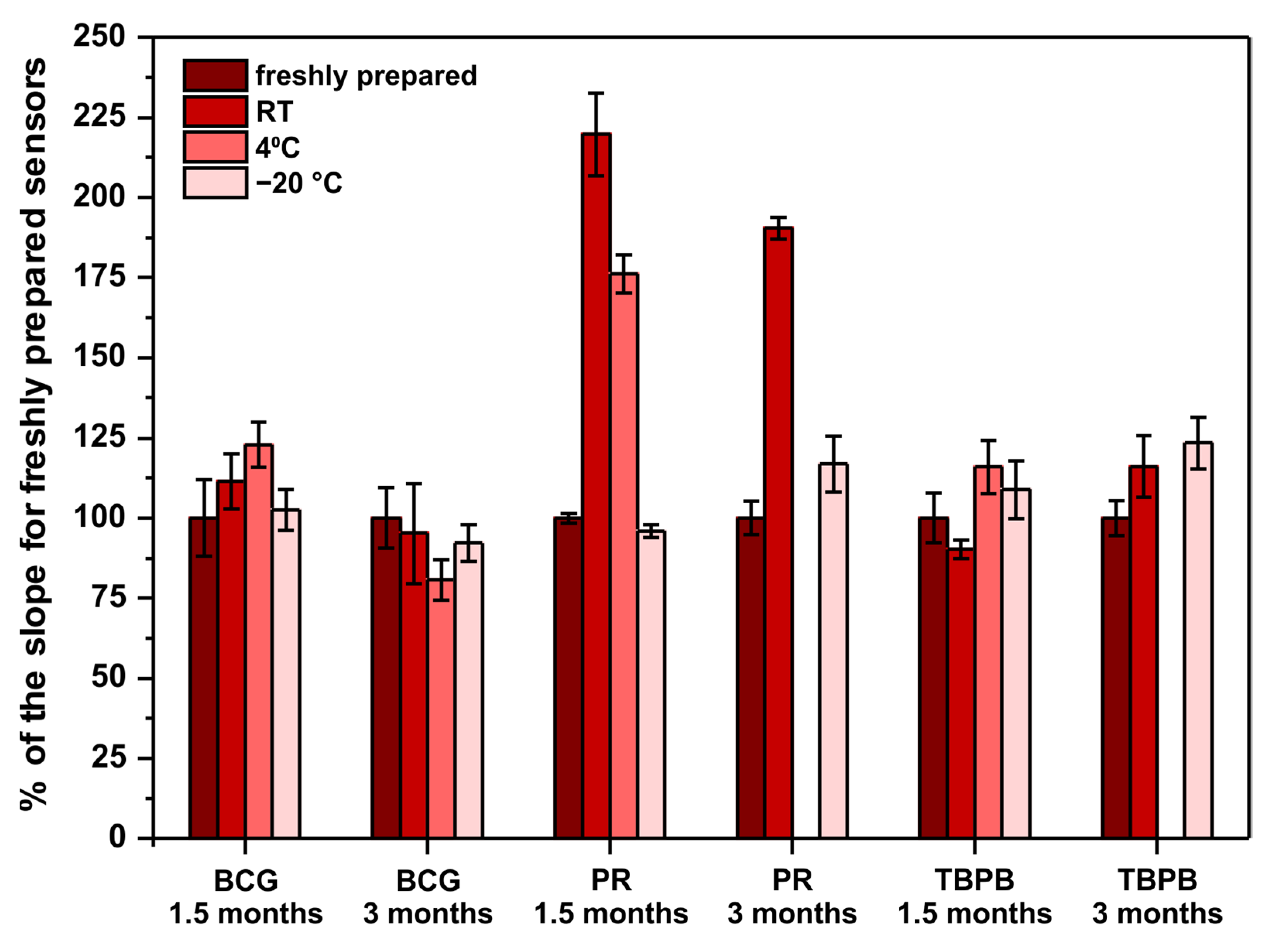
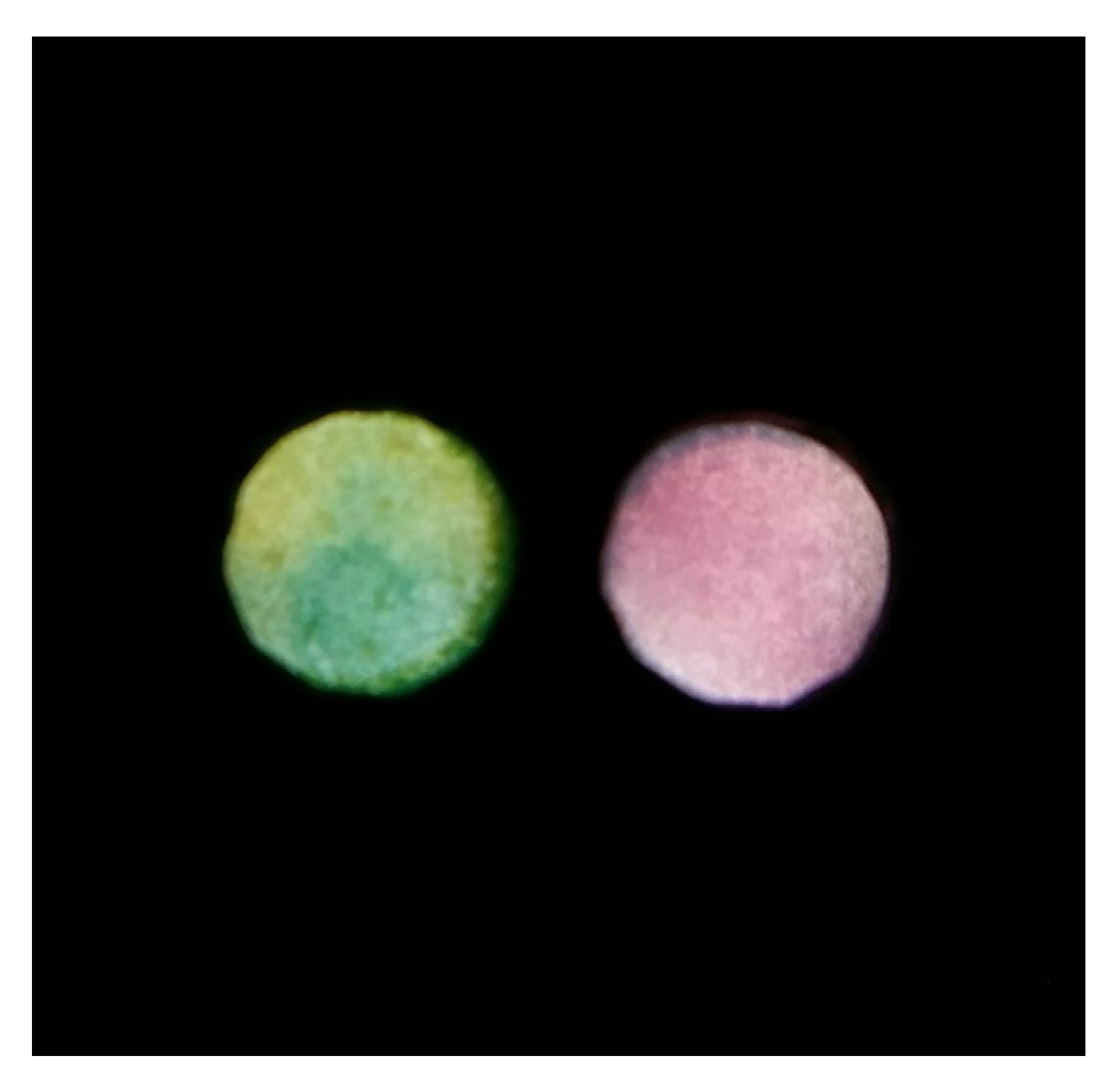
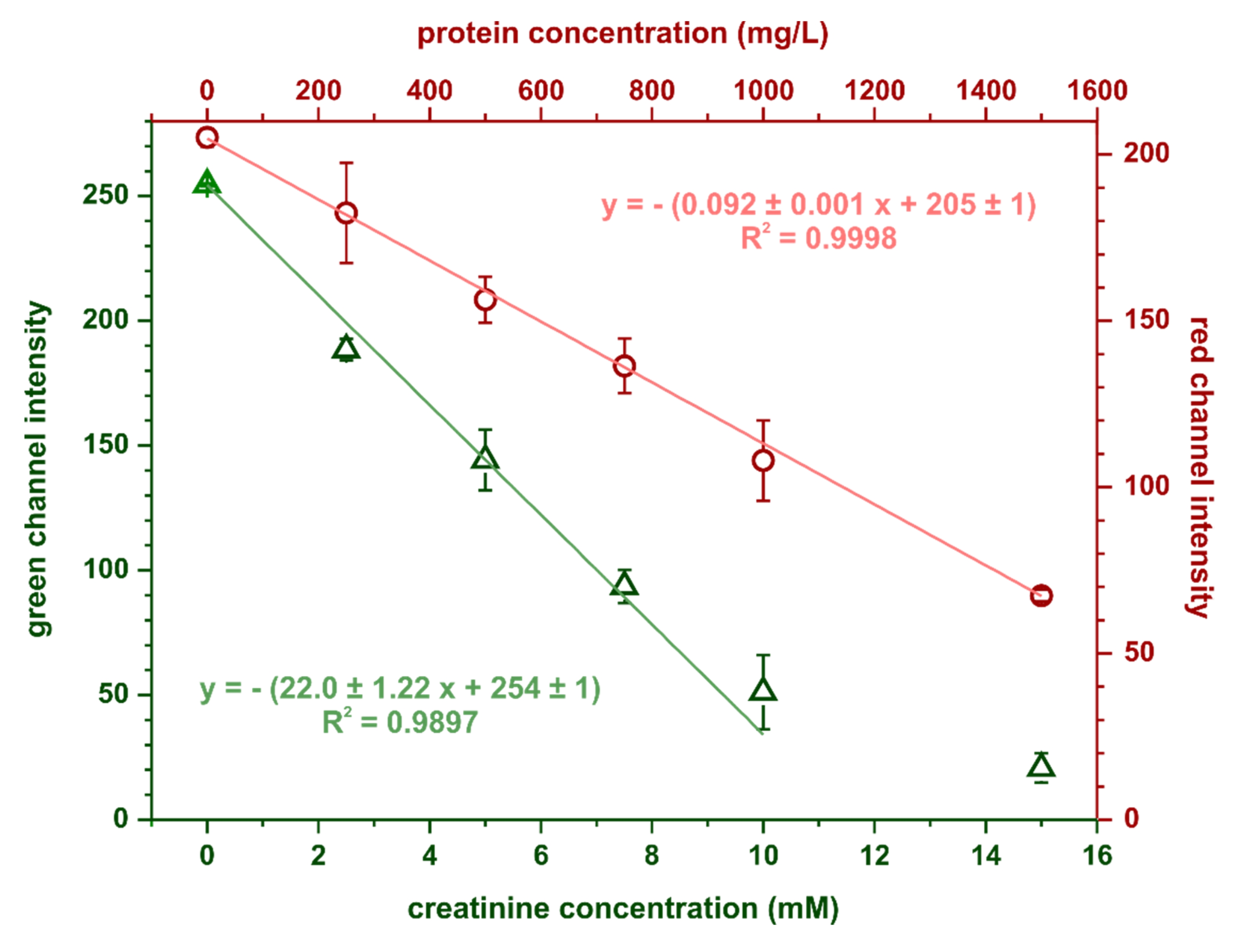

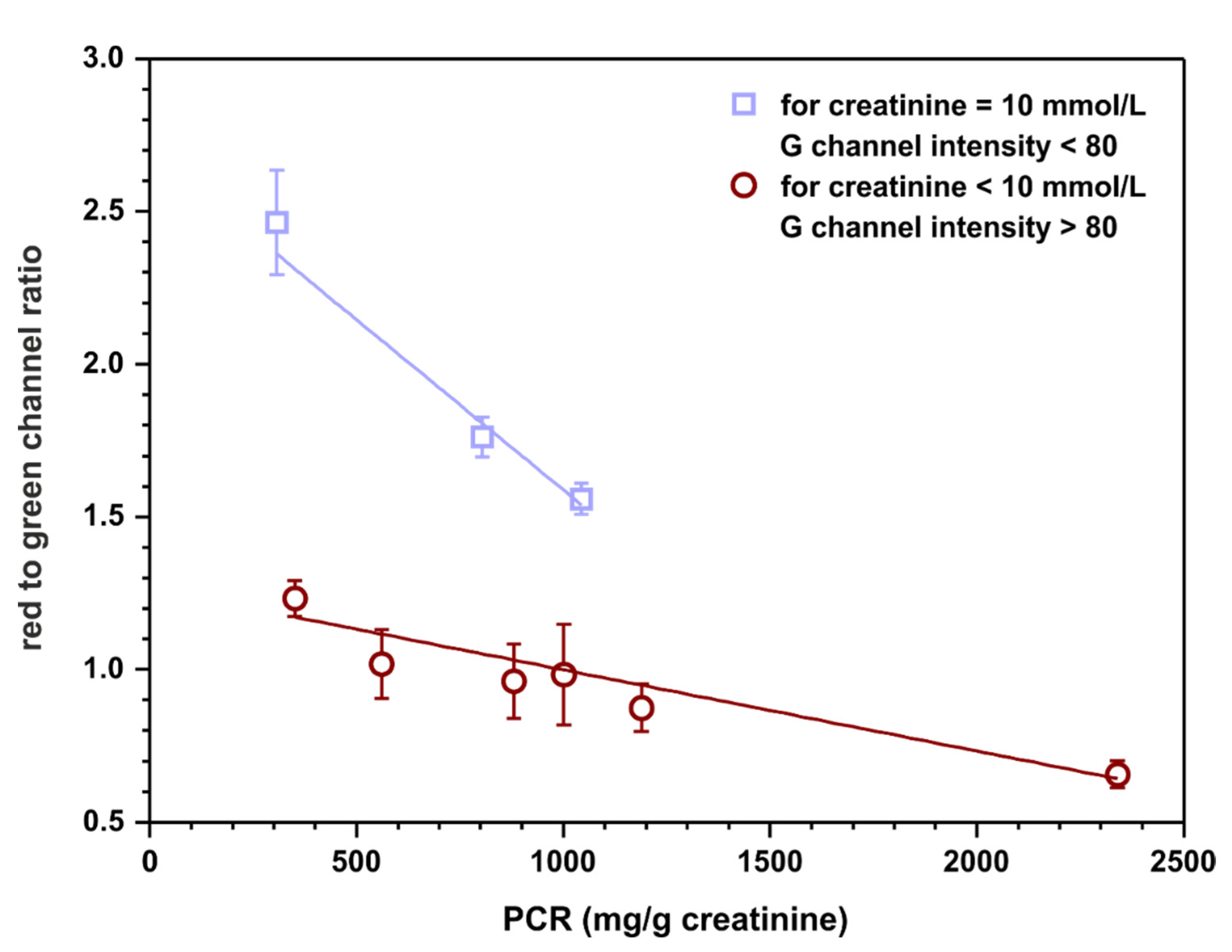
| Assay | Assay’s Principle | Initial Conditions | λmax | Ref. |
|---|---|---|---|---|
| bromocresol green (BCG) | BCG binds to albumins in acidic environment | [dye] = 0.6 mmol·L−1 in 0.95 mmol·L−1 citric buffer, pH 4.2 | 620 nm | [20] |
| pyrogallol red (PR) | PR-molybdate complex binds to proteins in acidic environment | [dye] = 0.06 mmol·L−1, [molybdate] = 0.04 mmol·L−1, in 50 mmol·L−1 succinic acid, 1 mmol·L−1 sodium oxalate, 3 mmol·L−1 sodium benzoate, pH 2.5 | 470 nm, 598 nm | [21] |
| ponceau S (PS) | Simultaneous PS binding and protein precipitation with TCA, pellet dissolution in sodium hydroxide | [dye] = 0.1 mmol·L−1 in 3% (w/v) trichloroacetic acid, 0.2 mol·L−1 sodium hydroxide for pellet dissolution | 546 nm | [22] |
| Bradford | Coomassie Brilliant Blue G binds to protein in acidic environment | [dye] = 100 mg·L−1, dissolved in ethanol, brought to volume with 85% phosphoric acid/water 1:9 (v/v) | 595 nm | [23] |
| BCA-Cu(II) | Cu(II) ions are reduced by peptide bonds to Cu(I) in alkaline environment, Cu(I) is detected by reaction with BCA | Reagent 1: 25 mmol·L−1 sodium bicinchominate, 190 mmol·L−1 sodium carbonate, 7 mmol·L−1 sodium tartate, 0.1 mol·L−1 sodium hydroxide, 0.1 mol·L−1 sodium bicarbonate, pH 11.2 Reagent 2: 0.16 mol·L−1 Cu(II), mix reagent 1 and reagent 2 in 50:1 (v/v) ratio | 562 nm | [24] |
| tetrabromophenol blue (TBPB) | TBPB binds to protein in an acidic environment | [dye] = 5 mmol·L−1 In 250 mmol·L−1 citric buffer, pH 3 | 610 nm | [13] |
| Parameter to Be Optimized | Parameter’s Value | Sensitivity [a.u./mg·L−1] * | R2 | Linear Range [mg·L−1] |
|---|---|---|---|---|
| bromocresol green method | ||||
| dye concentration [mmol·L−1] | 1 | −0.054 | 0.986 | 0–1000 |
| 2.5 | −0.057 | 0.992 | 100–1000 | |
| 5 | −0.040 | 0.995 | 100–1000 | |
| 10 | −0.033 | 0.901 | 300–1000 | |
| buffer pH | 3 | non-linear | - | - |
| 4 | −0.029 | 0.990 | 100–1000 | |
| 5 | −0.079 | 0.974 | 100–1000 | |
| 6 | −0.119 | 0.996 | 300–750 | |
| 7 | non-linear | - | - | |
| buffer concentration [mmol·L−1] | 1 | −0.072 | 0.990 | 0–1000 |
| 10 | −0.080 | 0.988 | 0–1000 | |
| 50 | -0.051 | 0.919 | 0–750 | |
| 100 | non-linear | - | - | |
| ISO parameter | 100 | −0.062 | 0.983 | 0–1000 |
| 200 | −0.078 | 0.983 | 100–1000 | |
| 400 | −0.074 | 0.993 | 100–1000 | |
| 800 | −0.048 | 0.997 | 100–1000 | |
| tetrabromophenol blue method | ||||
| dye concentration [mmol·L−1] | 2 | −0.040 | 0.979 | 100–750 |
| 5 | −0.041 | 0.997 | 10–750 | |
| 10 | −0.054 | 0.966 | 100–1000 | |
| 20 | −0.045 | 0.993 | 0–750 | |
| buffer pH | 2 | non-linear | - | - |
| 3 | −0.032 | 0.990 | 100–1000 | |
| 4 | −0.101 | 0.950 | 0–1000 | |
| 5 | −0.064 | 0.096 | 0–1000 | |
| buffer concentration [mmol·L−1] | 10 | −0.168 | 0.983 | 0–750 |
| 100 | −0.125 | 0.959 | 0–1000 | |
| 250 | −0.126 | 0.996 | 0–1000 | |
| 500 | −0.087 | 0.958 | 100–1000 | |
| ISO parameter | 100 | −0.098 | 0.958 | 0–1000 |
| 200 | −0.111 | 0.991 | 0–1000 | |
| 400 | −0.055 | 0.998 | 300–1000 | |
| 800 | −0.077 | 0.961 | 300–1000 | |
| pyrogallol red method | ||||
| dye concentration [mmol·L−1] ** | 0.05 | 0.0001 | 0.985 | 0–500 |
| 0.10 | 0.0003 | 0.964 | 0–500 | |
| 0.25 | 0.0007 | 0.984 | 0–500 | |
| 0.50 | 0.0014 | 0.999 | 0–500 | |
| 1.00 | 0.0014 | 0.999 | 10–1000 | |
| molybdate concentration [mmol·L−1] | 0.15 | 0.0006 | 0.981 | 0–500 |
| 0.33 | 0.0010 | 0.991 | 0–500 | |
| 0.50 | 0.0011 | 0.989 | 0–750 | |
| 1.00 | non-linear *** | - | - | |
| buffer pH | 2 | non-linear | - | - |
| 2.5 | 0.0015 | 0.997 | 0–500 | |
| 3 | 0.0014 | 0.972 | 0–750 | |
| 4 | non-linear | - | - | |
| buffer concentration: succinate, benzoate, oxalate [mmol·L−1] | 10, 0.2, 0.6 | 0.0008 | 0.973 | 0–1000 |
| 50, 1, 3 | 0.0006 | 0.985 | 0–750 | |
| 100, 2, 6 | 0.0003 | 0.986 | 0–750 | |
| ISO parameter | 100 | 0.0008 | 0.973 | 0–1000 |
| 200 | 0.0005 | 0.954 | 0–1000 | |
| 400 | 0.0004 | 0.998 | 0–750 | |
| 800 | 0.0002 | 0.991 | 0–750 | |
| Analytical Parameter | Bromocresol Green | Tetrabromophenol Blue | Pyrogallol Red |
|---|---|---|---|
| LOD * [mg·L−1] | 55 | 39 | 11 |
| LOQ * [mg·L−1] | 169 | 120 | 34 |
| precision [%] (at 100 mg·L−1 BSA) | 2.5 | 2.6 | 5.1 |
| precision [%] (at 750 mg·L−1 BSA) | 12 | 2.5 | 5.8 |
| Protein Concentration [mg·L−1] | Creatinine Concentration [mmol·L−1] | PCR [mg/g Creatinine] | Determined Protein Concentration [mg·L−1] | Determined Creatinine Concentration [mmol·L−1] | Determined PCR [mg/g Creatinine] | PCR Recovery [%] |
|---|---|---|---|---|---|---|
| 300 | 4.0 | 664 | 302 ± 82 | 4.8 ± 0.8 | 561 | 85 |
| 300 | 7.5 | 354 | 279 ± 20 | 7.0 ± 0.2 | 350 | 99 |
| 300 | 10 | 265 | 306 ± 27 | 8.8 ± 0.2 | 307 | 116 |
| 600 | 4.0 | 1327 | 654 ± 12 | 4.9 ± 0.4 | 1188 | 90 |
| 600 | 7.5 | 708 | 584 ± 50 | 6.4 ± 0.3 | 880 | 114 |
| 600 | 10 | 531 | 846 ± 22 | 9.3 ± 0.2 | 803 | 151 |
| 1000 | 4.0 | 2212 | 918 ± 65 | 4.7 ± 0.4 | 1744 | 79 |
| 1000 | 7.5 | 1180 | 701 ± 31 | 6.7 ± 0.1 | 926 | 79 |
| 1000 | 10 | 885 | 1097 ± 130 | 9.3 ± 0.3 | 1043 | 118 |
Publisher’s Note: MDPI stays neutral with regard to jurisdictional claims in published maps and institutional affiliations. |
© 2021 by the authors. Licensee MDPI, Basel, Switzerland. This article is an open access article distributed under the terms and conditions of the Creative Commons Attribution (CC BY) license (https://creativecommons.org/licenses/by/4.0/).
Share and Cite
Lewińska, I.; Kurdziałek, K.; Tymecki, Ł. Smartphone-Assisted Protein to Creatinine Ratio Determination on a Single Paper-Based Analytical Device. Molecules 2021, 26, 6282. https://doi.org/10.3390/molecules26206282
Lewińska I, Kurdziałek K, Tymecki Ł. Smartphone-Assisted Protein to Creatinine Ratio Determination on a Single Paper-Based Analytical Device. Molecules. 2021; 26(20):6282. https://doi.org/10.3390/molecules26206282
Chicago/Turabian StyleLewińska, Izabela, Karolina Kurdziałek, and Łukasz Tymecki. 2021. "Smartphone-Assisted Protein to Creatinine Ratio Determination on a Single Paper-Based Analytical Device" Molecules 26, no. 20: 6282. https://doi.org/10.3390/molecules26206282
APA StyleLewińska, I., Kurdziałek, K., & Tymecki, Ł. (2021). Smartphone-Assisted Protein to Creatinine Ratio Determination on a Single Paper-Based Analytical Device. Molecules, 26(20), 6282. https://doi.org/10.3390/molecules26206282





